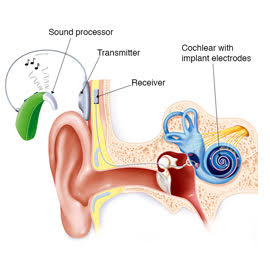Cochlear Implantation
A cochlear implant, which is a small electronic device, may be an option when hearing aids do not provide the clarity of sound needed to understand speech and spoken language.
The implant doesn't make you hear normally again, but it can help you with sounds. Most people with severe to profound hearing loss can understand speech in person or over the phone better than they did with a hearing aid.
Early intervention is key. Opportunity for improvement decreases over time as hearing loss worsens. This is especially true for children — an implant may have more benefit the sooner it is provided for a child.
Rehabilitation and training after surgery are required in order to achieve the best possible hearing ability.
Why it's done?
Cochlear implants may be placed in one ear (unilateral) or both ears (bilateral). Adults and children who are as young as six to 12 months old can benefit from cochlear implants.
People who have cochlear implants report improved:
- Ability to hear speech without needing visual cues such as reading lips.
- Recognition of normal, everyday environmental sounds.
- Ability to listen in a noisy environment.
- Ability to find where sounds are coming from.
- Ability to hear television programs, music and telephone conversations.

How does a cochlear implant work?

The external components capture environmental sounds as well as speech and music.

They process the sound so that it can be transmitted across the skin to the implant.

Individual electrodes deliver these signals to the hearing nerve.
Who requires cochlear implants?
Anyone who is suffering with severe to profound deafness, which means not being able to hear sound stronger than 90 dB HL at a frequency of 2 – 4 kHz (a measuring unit of intensity of sound) will need cochlear implants.
Apart from assessing functional hearing ability, a thorough assessment is also done by a multidisciplinary team before surgery to determine fitness for surgery and the ability of the person to derive benefit from a cochlear implant system.

Adults:
- Individuals 18 years of age or older.
- Moderate to profound hearing loss in both ears.
- Limited benefit from amplification defined by preoperative test scores of ≤50% sentence recognition in the ear to be implanted and ≤60% in the opposite ear or binaural.
Children:
- Severe to profound hearing loss.
- Limited benefit from binaural amplification.
- Multisyllabic Lexical Neighborhood Test (MLNT) or Lexical Neighborhood Test(LNT) scores ≤ 30%.
What Does Cochlear Implant Surgery Entail?
This is a fairly routine type of surgery for physicians who are trained in ear surgery (Otology, Neurology, and Skull Base Surgery). It takes about 1.5 hours and involves making an incision behind the ear.
The mastoid bone behind the ear is drilled to get to the inner ear and the electrode is placed. The incision is then closed, and a dressing applied.
Often the patient is kept in the hospital one night for observation, but in other cases the patient can be discharged home the same day as surgery. It is not particularly painful, and patients can resume their normal activities within 2-3 days, typically.
The implant is not turned on until the incision has fully healed, about 4 weeks after surgery.
What technologies are used in a cochlear implant?
A cochlear implant is made up of two parts. The external device consists of a microphone behind the ear that hears the sounds in the environment.
These sounds are then digitized and processed by a small computer called a speech processor. Small speech processing units can be hidden behind the ear, while larger ones have to be worn on your belt.
The signals from the speech processor are sent to the implanted part of the device though the skin using a magnet. The implanted part is an electronic device that is put under the skin behind the ear. An electrode connected to the device is inserted into the inner ear.
The electrode is simply a bundle of tiny wires that have open contacts spread out along the length of the cochlea. Thus, the electrical signals can be sent to different areas of the cochlea and represent different frequency sounds.
State-of-the art cochlear implant devices now have from 12 to 22 electrodes that stimulate the auditory nerve.
References
- 1. Sprinzl GM, Riechelmann H. Current trends in treating hearing loss in elderly people: a review of the technology and treatment options – a mini-review. Gerontology. 2010;56(3):351–8. [PubMed].
- 2.Gates GA, Rees TS. Hear ye? Hear ye! Successful auditory aging. West J Med. 1997 October;167(4):247–52. [PMC free article][PubMed].
- 3. Bond M, Mealing S, Anderson R, et al. The effectiveness and cost-effectiveness of cochlear implants for severe to profound deafness in children and adults: a systematic review and economic model. Health Technol Assess.2009 September;13(44):1–330. [PubMed].
- 4. Isaacson B, Lee KH, Kutz JW, Roland PS, Sargent EW. Cochlear Implants, Indications. emedicine medscape com. Jun 25, 2010. Available at: URL: URL: http://emedicine.medscape.com/article/857164-overview.
- 5. URL:https://www.hopkinsmedicine.org/health/treatment-tests-and-therapies/cochlear-implant-surgery.
- 6. URL:https://www.mayoclinic.org/tests-procedures/cochlear-implants/about/pac-20385021.

